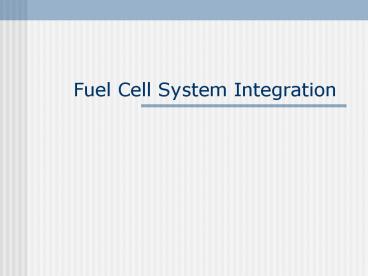Fuel Cell System Integration PowerPoint PPT Presentation
1 / 9
Title: Fuel Cell System Integration
1
Fuel Cell System Integration
2
Synthesis and Design
- Synthesis determine the components to use and
their relationship to each other - Design determine the conditions at which the
various components will operate
3
FC System Synthesis Decisions
- Fuel cell type
- Choices PEMFC, DMFC, PAFC, MCFC, SOFC
- Factors to consider - cost, efficiency, operating
temperature, available fuel - Fuel cell stack configuration
- Number and size of cells
- Cooling design
- Assembly of cells into stacks or sub-stacks
- Fuel reformer
- Type of reformer
- Choices - Steam reforming, partial oxidation,
autothermal - Factors to consider - Source fuel, desired exit
gas composition, efficiency vs. complexity,
weight, cost, etc. - Reformate clean-up components
- Choices shift reactors, PROX, membrane
separation, PSA - Factors to consider cost, efficiency, desired
composition
4
FC System Synthesis Decisions (continued)
- Integration of stack and reformer external,
internal indirect, internal direct - Air compressor - compressor type (screw or
centrifugal), intercooler - Heat exchanger network type, location
- Exit gas components condensers, turboexpanders,
heat exchangers - Bottoming cycle equipment
- Gas turbine
- Steam power cycle
5
FC Design Decisions - Voltage
- Stack operating voltage
6
FC Design Decisions - Pressure
- Higher operating pressure yields
- Increased reactant concentration increased
electrochemical kinetics higher Nernst voltage - Higher efficiency and/or current density
- Reduced system size
- Reduced humidification requirements
- Higher parasitic power requirements
- Higher likelihood of soot formation in reformer
- Reduced degree of reaction for steam reforming
- Higher corrosion rates at cathode (MCFC)
7
FC Design Decisions - Utilization
- Higher fuel utilization (lower equivalence ratio)
yields - Reduced fuel use within the stack
- Reduced fuel processing system size, cost
- Lower cell voltage
- Higher stack cost
- Less exit gas for application in bottoming cycle
- Higher oxidant utilization (lower equivalence
ratio) yields - Reduced compressor power
- Reduced air system size, cost
- Reduced humidification requirements
- Lower cell voltage
- Higher stack cost
8
FC Design Decisions Temperature
- Higher operating temperature yields
- Increased operating voltage
- More flexible thermal integration
- Less exotic catalyst and resistance to poisoning
- Higher quality rejected heat
- Increased corrosion potential (especially PAFC,
MCFC) - Longer warm-up and higher thermal stress
- Increased complexity
9
FC Design Decisions Etc.
- Higher reactant humidification yields
- Higher cell voltage (PEMFC)
- Higher resistance to carbon formation in reformed
fuels - Increased cost of water (or equipment to condense
from exit stream) - Increased capital cost and complexity
- Potential for flooding
- Increased size (and number) of heat exchangers
yields - Improved quality and quantity of thermal energy
available - Better system integration possibly improving
overall electrical efficiency - Increased cost

